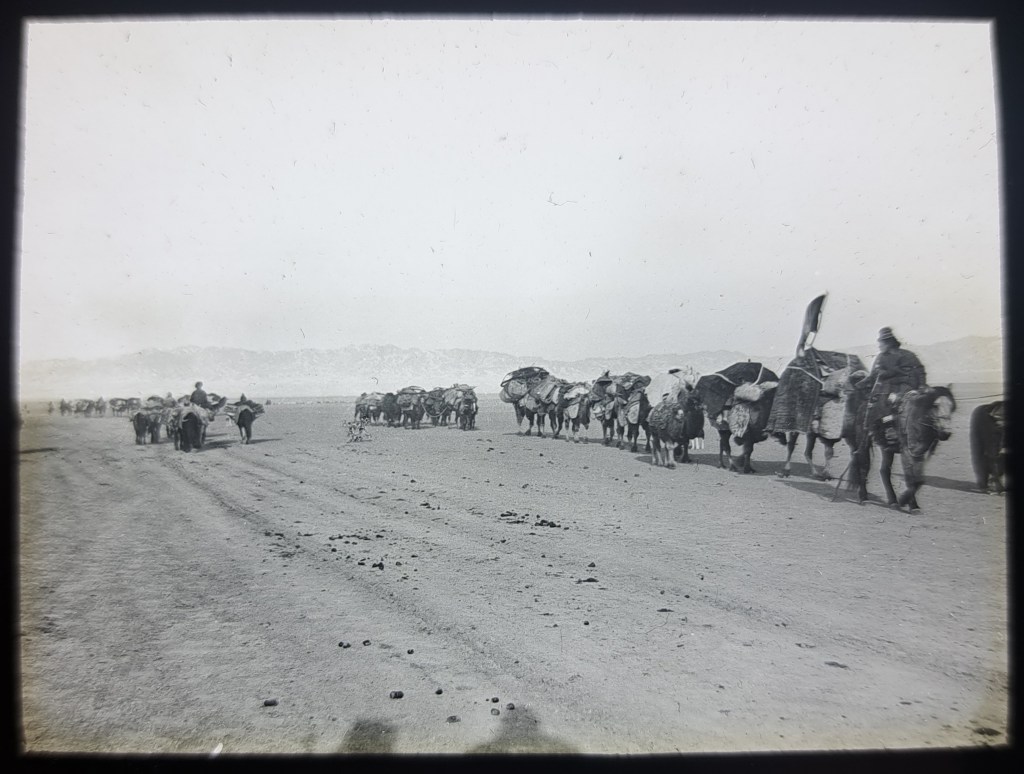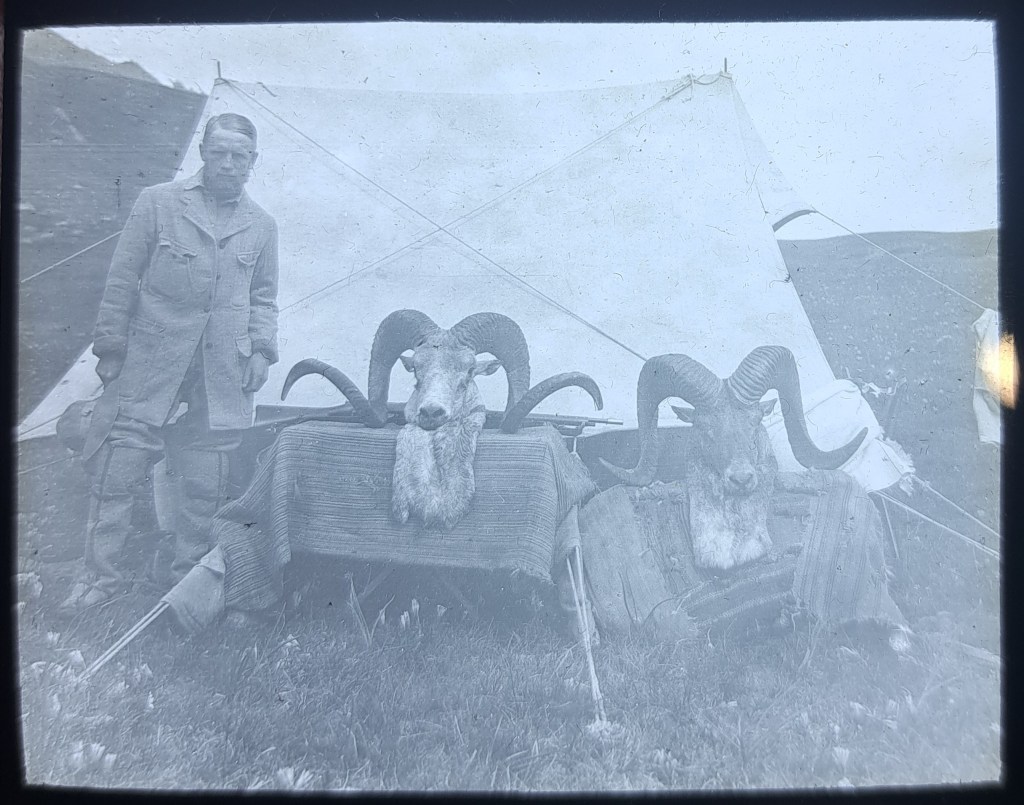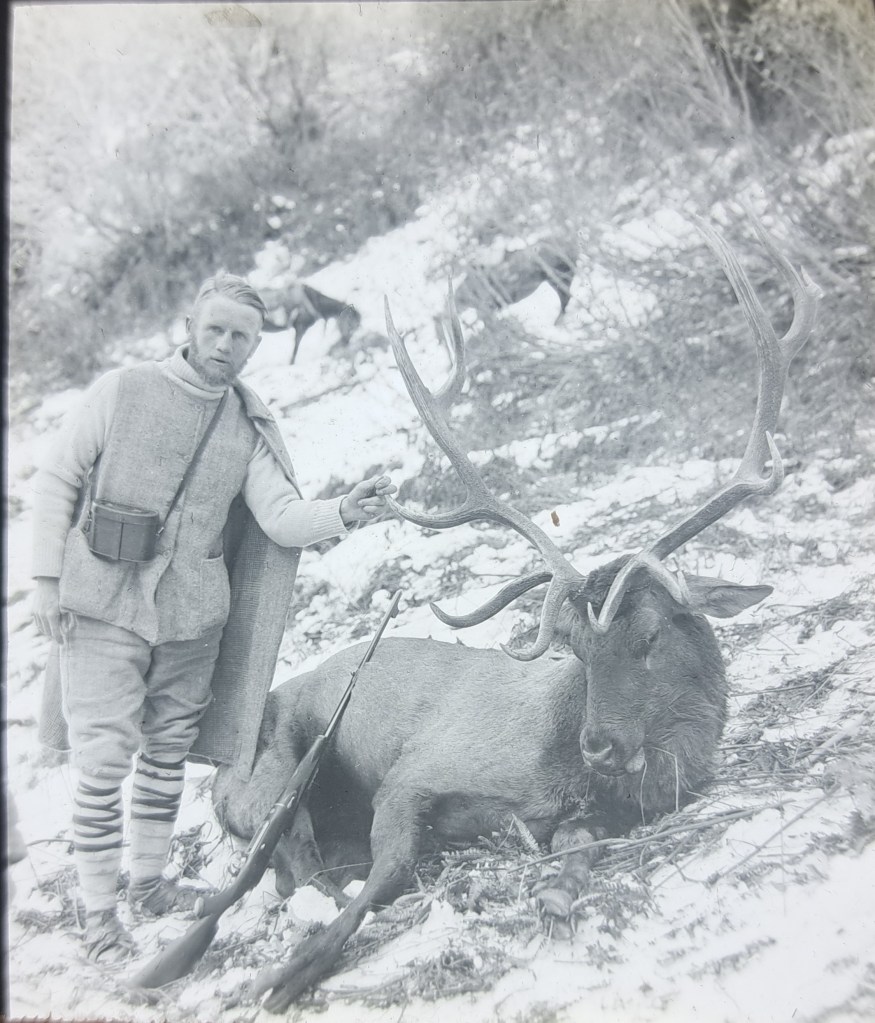For some time I have been collecting early photographic images of Central Asia. They are not easy to come by, not least because few people travelled in these remote regions and even fewer of them carried cameras. However, this week I was fortunate enough to obtain a stunning set of 86 magic lantern slides that illustrate a hunting trip through Central Asia and which date from about 1900.
For those of you who do not know, the magic lantern was a precursor to the slide projector. A very thin photographic ‘positive’ measuring 3.25 inches x 3.25 inches was sandwiched between two sheets of glass and bound at the edges with tape. It was a primitive system, but often the quality of the photographs, mostly taken with plate cameras, was superb.
From what I can work out from the captions attached to each slide, the expedition leader – who I have not yet identified – set off from Srinagar in Kashmir, northern India, before heading north to Gilgit and Hunza. From there he crossed the Pamirs and then travelled on to Kashgar in modern-day Xinjiang. From there he headed to Aksu and then into the Tekkes Valley in the Tian Shan Mountains to hunt. He then made his way via the border crossing at Chuguchak (now Tacheng) into what was then Russian-controlled Turkestan, but which is now in modern-day eastern Kazakhstan. He passed through Sergiopol (now Ayaguz) before heading north into Siberia. By any account, this was a remarkable journey that required great stamina and determination.
Throughout this journey our traveller was hunting. The slides include his trophies, including ibex, Marco Polo sheep, roedeer, huge Asiatic wapiti or maral (red deer) and, sadly, snow leopards. One of the slides says that his Ovis littledalei had horns that measured 57.5 inches across, which he says was a record. But the real question is who is this person. Can you help? I know that it is not Captain HHP Deasy, who published In Tibet and Chinese Turkestan in 1901. Nor does it appear to be Percy Church, whose In Chinese Turkestan with Caravan and Rifle was published the same year, even though the route was very similar, as were the hunting trophies. However, I am reasonably sure that he is English.

So here are some pictures of the hunter. If you can help to identify him, please let me know. He is shown here with some of his hunting trophies.
As you can see, his features are very clear. Please get in touch if you can put a name to the face.




This may be of no help at all – but reading your post put me in mind of Capt. Malcolm M’Neill “a big-game hunter” who is mentioned in John Service (ed.), ‘Golden Inches: The China Memoir of Grace Service’ (Berkeley & Los Angeles: University of California Press, 1989), Chapter 13 – locating him in West China / East Tibet frontier, 1908. He’s also mentioned in the West China travel memoirs of botanist, Ernest Henry Wilson who was travelling in the same area around this time too. I’ve not yet been able to find out anything about Capt. Malcolm M’Neill (as both Service and Wilson spell his name) or what he looked like – unless M’Neill is actually Capt. Malcolm McNeill, who wrote ‘In Pursuit of the “Mad” Mullah: Service and Sport in the Somali Protectorate’ (1902), in which case he looks quite different to the hunter in your photos … Anyhow, I hope you manage to put a name to your collection – Best wishes, Tim
LikeLike
Thanks Tim,
I will check out this possibility. In the meantime I have found reference to one of the Indian shikaris (hunters) called Rahima who accompanied this expedition. From the picture he could be the same Rahima who acted as shikari for Theodore and Kermit Roosevelt, as described in their book East of the Sun and West of the Moon. It is written at the same time and it would not be unusual for Brits/Americans to work with the same small group of shikaris who knew how to stalk and skin trophies.
I thought at first it could be Percy Church, but this does not appear to be the same person. Could it be any of his companions? I have also come across an American photographer called Isidore Morse, whose pictures were used by Church in his book on hunting in Turkestan. Not sure they are by him, but I think I am closing in.
By any standard this is a superb set of pics and although I have no interest in hunting or hunters, to find such a near-complete set is unusual to say the least.
LikeLike
Wow, what a find. Hope you can identify the man! Merry Christmas!
LikeLike
Thanks Paul,
We are narrowing the field and I am pretty certain we will find him in the end.
Very best Season’s Greetings to all in Hawaii!
LikeLike
Good to hear from you, Nick.
I love lantern slides, and what a treasure trove these little darlings are.
My short answer is I have no idea who the mystery gentleman is, although he is particularly fair and looks Scandinavian.
I wondered about Hendrik “Henrik” Sillem, a Dutch mountaineer and sporting shooter who, in 1902, climbed Nun in Kashmir. I don’t think it is him, but perhaps someone from his circle.
Perhaps the mention of his record specimen, Ovis littledalei, may hold a clue. I’ve used Wards, who record the best big game specimens, to track Dalgleish’s conquests. The Bombay Natural History Society was always interested to hear about a record specimen, and it may be worth a look. Another publisher interested in Great Game was LYDEKKER.
I’ve looked at my photograph collection, but no one resembles the mystery man.
Undoubtedly you have searched The Civil and Military Gazette and the Pioneer for any exploratory Caravans coming and going from Srinagar. Even The Times of India is worth a shot.
I keep copies of a few books downloaded from the Internet Archive, and they mention meeting fellow travellers along the pathways. You may have already searched these, but here are a few from around 1900.
Around Afghanistan by MAJOR DE BOUILLANE DE LACOSTE. I find this to be a work of exquisite lyrical description.
A Foot Through the Kashmir Valleys by Marion Doughty (1909)
Innermost Asia by Ralph P Cobbold (1900)
I’ll be in London in May 2023. Would you like to meet up for a coffee and chat about research?
In the meantime, have a wonderful Xmas.
Regards,
Jennifer Teh
LikeLike
Hi Jennifer,
Good to hear from ou and many thanks for your suggestions as to the identity of my mystery hunter. I had forgotten about Cobbold. He covered a similar route, although he returned to India instead of heading to Omsk in Siberia like this hunter. However, he mentions many of the same places. And I would be delighted to see you in London in May. Let me know your dates.
Nick
LikeLike
Please have a look https://twitter.com/hausibek/status/1607016571976953857
LikeLike
Many thanks Marcus,
Huntington is a very good candidate. I have his superb book The Pulse of Asia, which promotes the theory that there is a geographical relationship between the physical envornment and humans and between changes of climate and history, to both of which I am sympathetic. However, this particular hunting trip illustrated by the slides does not fully accord with the journey outlined in his book, in which he travelled further to the east ie Lop Nor and Urumchi. Nor does he mention Sairam Nor, Gildgit, Hunza or Maralbashi in the book, all of which are the subject of slides. True, he ends his journey at Omsk, as does our mystery traveller. Is it possible he was involved in other trips during his three years in Central Asia at the beginning of the 20th century?
LikeLike
Pleasure! I love to dig in my Archive to help others.
Please see this file from Yale, entitled.
“1905/1906 Expedition to India, Chinese Turkestan and Siberia #H1 – H483”
https://archives.yale.edu/repositories/12/archival_objects/2040312
Perhaps this was a confidential trip (India) that he was not allowed to publish anything about at the time. As have others before him (Cobbold, Earl of Dunmore etc).
There is also an unpublished manuscript labelled “Adventures in Asia”
https://archives.yale.edu/repositories/12/archival_objects/2039189
Or this unpubished article “Kashgar in the Heart of Asia, handwritten draft and typescript, Undated”
https://archives.yale.edu/repositories/12/archival_objects/2039423
Unfortunately Yale is not just around the corner for me, otherwise I would love to have a look at these files.
You need to start a new blog now about Ellsworth Huntington’s journey in Central Asia with this photographic collection in hand! 🙂
LikeLike
Once again, many thanks Marcus,
I will contact the library in the New Year and try to get access to the files you mention. How certain are you that this is Ellsworth Huntington? If it is him, it would undoubtedly be of importance.
LikeLike